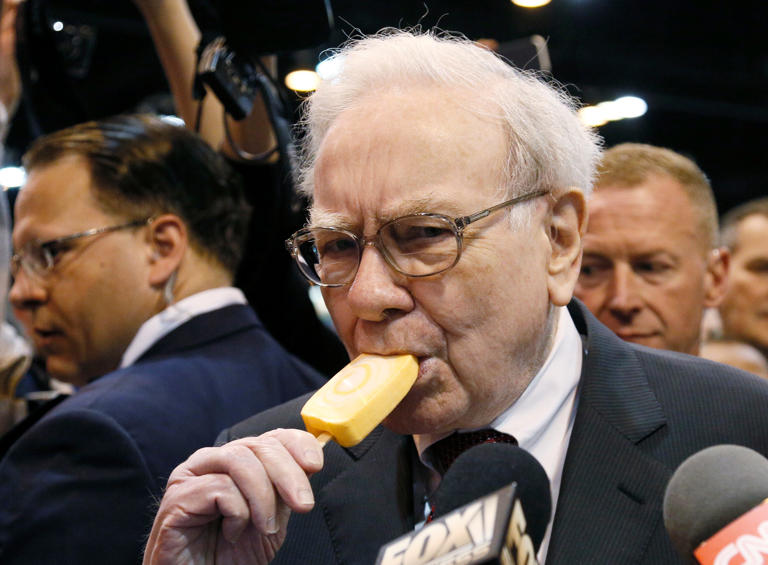Key Takeaways:
- Warren Buffett’s recent letter to shareholders revealed impressive statistics, including Berkshire Hathaway’s return under his leadership, which stood at 4,400,000%, far surpassing the S&P 500’s return of 31,000%.
- The letter highlighted Berkshire Hathaway’s profitability from investments in bonds.
- Berkshire Hathaway currently holds a significant cash reserve of $168 billion, surpassing the market capitalization of companies like Uber and Nike.
Warren Buffett’s annual letter to Berkshire Hathaway shareholders, a long-standing tradition spanning almost six decades, was released on Saturday.
In his latest letter, the renowned investor shared a plethora of insightful nuggets and highlights from the full-year report, offering valuable insights for attentive readers.
Let’s delve into six of the most noteworthy takeaways from Buffett’s latest missive.
1. Crushing the market
As of December 31, Berkshire Hathaway’s stock has soared by nearly 4,400,000% since Warren Buffett assumed control in 1965. This remarkable performance surpasses the S&P 500’s gain of 31,000% over the same period, equating to a compounded annual gain of 19.8% compared to the index’s 10.2% annual gain.
Furthermore, Berkshire Hathaway’s stock has surged an additional 16% this year, outpacing the S&P 500’s 7% advance and further widening its lead over the index. For investors who entrusted $100 to Buffett at the beginning of his tenure at Berkshire, their investment would now be valued at well over $400 million.
2. Assets aplenty
As of the end of December, Berkshire Hathaway reported net assets totaling $561 billion, reflecting a substantial 19% increase compared to the previous year.
Warren Buffett highlighted that this figure stands as the largest net-asset recorded for any American business. Notably, it represents approximately 6% of the total worth of the S&P 500 in 2022, amounting to $9.5 trillion.
Berkshire Hathaway’s expansive portfolio of assets, exceeding $1 trillion, includes $354 billion in stocks, $178 billion in property and equipment, $130 billion in Treasury bills, and $24 billion in inventories.
Conversely, the company’s liabilities, totaling nearly $500 billion, encompass unpaid losses, unearned premiums, and healthcare benefits associated with its insurance and other business operations.
3. Money to burn
As of December 31, Berkshire Hathaway’s cash and short-term investments surged to an unprecedented $168 billion, marking a substantial $60 billion increase in just 15 months.
This impressive cash reserve surpasses the market capitalization of several prominent companies, including General Electric ($167 billion), Comcast ($166 billion), Uber ($162 billion), Nike ($160 billion), Walmart ($159 billion), American Express ($156 billion), and Pfizer ($155 billion).
4. Cash-positive
Buffett and his team have encountered challenges in identifying attractive investment opportunities in recent years. The prolonged bull market has propelled stock prices to record highs, while intense competition from private-equity firms has driven up acquisition costs. Additionally, Berkshire’s own soaring stock price has diminished the appeal of buybacks.
As of December 31, Berkshire Hathaway held $354 billion in stocks and $168 billion in cash and other short-term investments, resulting in a ratio of nearly 2-to-1.
Buffett has consistently expressed a preference for owning productive assets such as stocks and businesses over holding cash or bonds. Therefore, the notable presence of cash and Treasuries, comprising nearly one-third of Berkshire’s portfolio, underscores the scarcity of compelling investment opportunities in the current market environment.
5. Renewed interest
Last year, Berkshire Hathaway generated approximately $6.1 billion in interest and other investment income, a substantial increase from the $589 million collected in 2021 and surpassing the $5.5 billion earned from dividends in 2023.
Buffett and his team primarily attributed this significant surge to higher interest rates. In response to historic inflation levels, the Federal Reserve hiked its benchmark rate from nearly zero to over 5% between spring 2022 and last summer, consequently boosting the yields on government bonds.
Previously, Berkshire had earned only a negligible amount of interest on its cash and bonds. However, with the change in interest rates, the company can now achieve a solid return on these investments while Buffett continues his pursuit of exceptional businesses to acquire.
6. Tiny headquarters
Last year, Berkshire Hathaway’s total workforce expanded to nearly 400,000 employees, with only 26 of them stationed at the company’s headquarters in Omaha, Nebraska.
This decentralized structure was designed by Charlie Munger, whom Buffett praised as the “architect” to his “general contractor.” Under Munger’s guidance, Berkshire operates as a network of autonomous subsidiaries.
These subsidiaries, ranging from Geico with 30,584 employees to Pampered Chef with 309, function independently and direct their profits to the headquarters.
This decentralized approach enables Buffett to focus on his core strengths: allocating capital both within and outside the company, while leaving the day-to-day management of the subsidiaries to capable hands.
